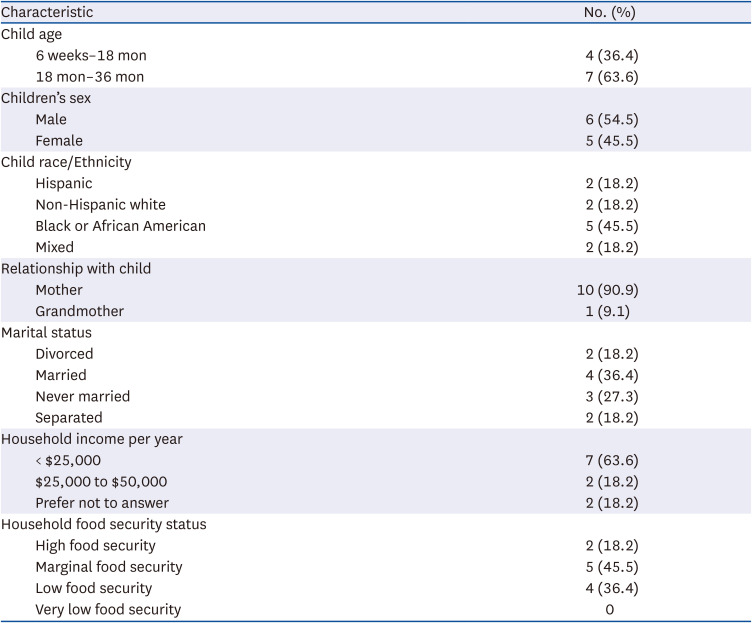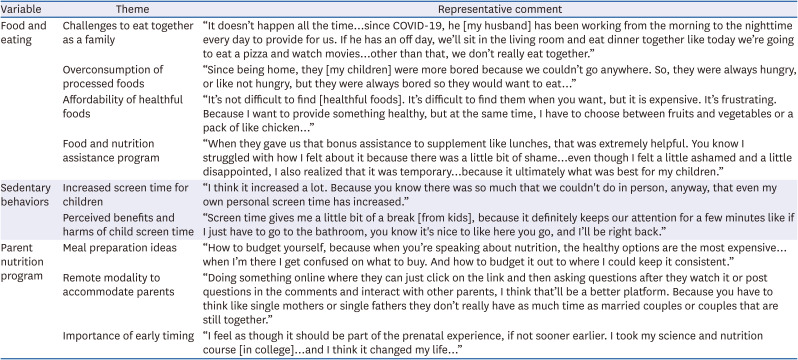3. Fryar CD, Carroll MD, Afful J. Prevalence of overweight, obesity, and severe obesity among adults aged 20 and over: United States, 1960–1962 through 2017–2018. NCHS Health E-Stats. Hyattsville (MD): National Center for Health Statistics;2021.
4. Weaver RG, Brazendale K, Hunt E, Sarzynski MA, Beets MW, White K. Disparities in childhood overweight and obesity by income in the United States: an epidemiological examination using three nationally representative datasets. Int J Obes. 2019; 43:1210–1222.
5. Isong IA, Rao SR, Bind MA, Avendaño M, Kawachi I, Richmond TK. Racial and ethnic disparities in early childhood obesity. Pediatrics. 2018; 141:e20170865. PMID:
29269386.
6. Hansen AR, Duncan DT, Tarasenko YN, Yan F, Zhang J. Generational shift in parental perceptions of overweight among school-aged children. Pediatrics. 2014; 134:481–488. PMID:
25157001.
8. United States Census Bureau. Quick facts: Texas [Internet]. Washington, D.C.: United States Census Bureau;2021. cited 2023 January 3. Available from:
https://www.census.gov/quickfacts/TX.
9. Sahoo K, Sahoo B, Choudhury AK, Sofi NY, Kumar R, Bhadoria AS. Childhood obesity: causes and consequences. J Family Med Prim Care. 2015; 4:187–192. PMID:
25949965.
10. Hoffmans MD, Kromhout D, de Lezenne Coulander C. The impact of body mass index of 78,612 18-year old Dutch men on 32-year mortality from all causes. J Clin Epidemiol. 1988; 41:749–756. PMID:
3418364.
11. Rankin J, Matthews L, Cobley S, Han A, Sanders R, Wiltshire HD, Baker JS. Psychological consequences of childhood obesity: psychiatric comorbidity and prevention. Adolesc Health Med Ther. 2016; 7:125–146. PMID:
27881930.
12. Schwimmer JB, Burwinkle TM, Varni JW. Health-related quality of life of severely obese children and adolescents. JAMA. 2003; 289:1813–1819. PMID:
12684360.
13. Dehghan M, Akhtar-Danesh N, Merchant AT. Childhood obesity, prevalence and prevention. Nutr J. 2005; 4:24. PMID:
16138930.
14. Davison KK, Birch LL. Childhood overweight: a contextual model and recommendations for future research. Obes Rev. 2001; 2:159–171. PMID:
12120101.
15. Pietrobelli A, Pecoraro L, Ferruzzi A, Heo M, Faith M, Zoller T, Antoniazzi F, Piacentini G, Fearnbach SN, Heymsfield SB. Effects of COVID-19 Lockdown on lifestyle behaviors in children with obesity living in Verona, Italy: a longitudinal study. Obesity (Silver Spring). 2020; 28:1382–1385. PMID:
32352652.
16. Lee H, Oldewage-Theron W, Dawson JA. Effects of a theory-based, multicomponent eHealth intervention for obesity prevention in young children from low-income families: a pilot randomized controlled study. Nutrients. 2023; 15:2296. PMID:
37242179.
17. Bickel G, Nord M, Price C, Hamilton W, Cook J. Guide to measuring household food security (revised 2000) [Internet]. Washington, D.C.: United States Department of Agriculture;2000. cited 2023 January 3. Available from:
https://nhis.ipums.org/nhis/resources/FSGuide.pdf.
18. DeJonckheere M, Vaughn LM. Semistructured interviewing in primary care research: a balance of relationship and rigour. Fam Med Community Health. 2019; 7:e000057. PMID:
32148704.
19. Torkan N, Kazemi A, Paknahad Z, Bahadoran P. Relationship of social cognitive theory concepts to dietary habits of pregnant women. Iran J Nurs Midwifery Res. 2018; 23:125–130. PMID:
29628960.
20. Young MD, Plotnikoff RC, Collins CE, Callister R, Morgan PJ. Social cognitive theory and physical activity: a systematic review and meta-analysis. Obes Rev. 2014; 15:983–995. PMID:
25428600.
21. Michie S, Richardson M, Johnston M, Abraham C, Francis J, Hardeman W, Eccles MP, Cane J, Wood CE. The behavior change technique taxonomy (v1) of 93 hierarchically clustered techniques: building an international consensus for the reporting of behavior change interventions. Ann Behav Med. 2013; 46:81–95. PMID:
23512568.
22. Creswell JW, Poth CN. Qualitative Inquiry & Research Design: Choosing Among Five Approaches. 3rd ed. Thousand Oaks (CA): SAGE Publications, Inc.;2008.
23. Hammons AJ, Fiese BH. Is frequency of shared family meals related to the nutritional health of children and adolescents? Pediatrics. 2011; 127:e1565–e1574. PMID:
21536618.
24. Fink SK, Racine EF, Mueffelmann RE, Dean MN, Herman-Smith R. Family meals and diet quality among children and adolescents in North Carolina. J Nutr Educ Behav. 2014; 46:418–422. PMID:
24974356.
25. Philippe K, Chabanet C, Issanchou S, Monnery-Patris S. Child eating behaviors, parental feeding practices and food shopping motivations during the COVID-19 lockdown in France: (How) did they change? Appetite. 2021; 161:105132. PMID:
33493611.
26. van der Horst K, Sleddens EF. Parenting styles, feeding styles and food-related parenting practices in relation to toddlers’ eating styles: a cluster-analytic approach. PLoS One. 2017; 12:e0178149. PMID:
28542555.
27. Sim AY, Lim EX, Forde CG, Cheon BK. Personal relative deprivation increases self-selected portion sizes and food intake. Appetite. 2018; 121:268–274. PMID:
29170121.
32. Morales ME, Berkowitz SA. The Relationship between food insecurity, dietary patterns, and obesity. Curr Nutr Rep. 2016; 5:54–60. PMID:
29955440.
33. Sharma SV, Chuang RJ, Rushing M, Naylor B, Ranjit N, Pomeroy M, Markham C. Social determinants of health-related needs during COVID-19 among low-income households with children. Prev Chronic Dis. 2020; 17:E119. PMID:
33006541.
34. Chilton M, Rabinowich J, Council C, Breaux J. Witnesses to hunger: participation through photovoice to ensure the right to food. Health Hum Rights. 2009; 11:73–85. PMID:
20845852.
35. Fang D, Thomsen MR, Nayga RM Jr. The association between food insecurity and mental health during the COVID-19 pandemic. BMC Public Health. 2021; 21:607. PMID:
33781232.
36. Nagata JM, Cortez CA, Cattle CJ, Ganson KT, Iyer P, Bibbins-Domingo K, Baker FC. Screen time use among US adolescents during the COVID-19 pandemic: findings from the Adolescent Brain Cognitive Development (ABCD) study. JAMA Pediatr. 2022; 176:94–96. PMID:
34724543.
37. Lampard AM, Jurkowski JM, Davison KK. The family context of low-income parents who restrict child screen time. Child Obes. 2013; 9:386–392. PMID:
24004326.
38. American Academy of Pediatrics (AAP) Committee on Nutrition. Feeding the child and adolescent. Kleinman RR, Greer FR, editors. Pediatric Nutrition. 7th ed. Itasca (IL): AAP;2013. p. 143–162.






 PDF
PDF Citation
Citation Print
Print



 XML Download
XML Download